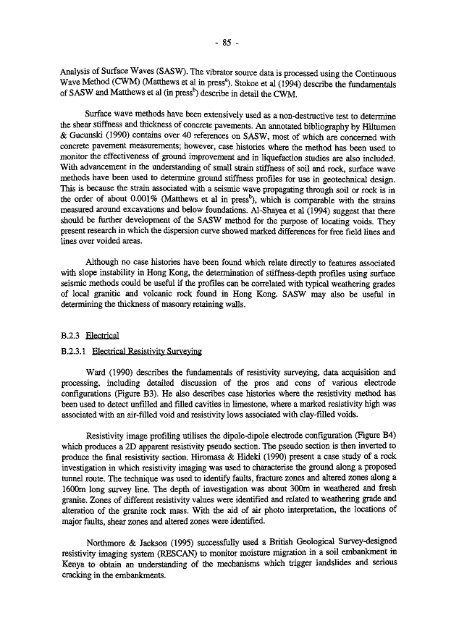site characterisation study - phases 1 and 2 - HKU Libraries - The ...
site characterisation study - phases 1 and 2 - HKU Libraries - The ...
site characterisation study - phases 1 and 2 - HKU Libraries - The ...
- No tags were found...
You also want an ePaper? Increase the reach of your titles
YUMPU automatically turns print PDFs into web optimized ePapers that Google loves.
- 85 -Analysis of Surface Waves (SASW). <strong>The</strong> vibrator source data is processed using the ContinuousWave Method (CWM) (Matthews et al in press*). Stokoe et al (1994) describe the fundamentalsof SASW <strong>and</strong> Matthews et al (in press b ) describe in detail the CWM.Surface wave methods have been extensively used as a non-destructive test to determinethe shear stiffness <strong>and</strong> thickness of concrete pavements. An annotated bibliography by Hiltumen& Gucunski (1990) contains over 40 references on SASW, most of which are concerned withconcrete pavement measurements; however, case histories where the method has been used tomonitor the effectiveness of ground improvement <strong>and</strong> in liquefaction studies are also included.With advancement in the underst<strong>and</strong>ing of small strain stiffness of soil <strong>and</strong> rock, surface wavemethods have been used to determine ground stiffness profiles for use in geotechnical design.This is because the strain associated with a seismic wave propagating through soil or rock is inthe order of about 0.001% (Matthews et al in press b ), which is comparable with the strainsmeasured around excavations <strong>and</strong> below foundations. Al-Shayea et al (1994) suggest that thereshould be further development of the SASW method for the purpose of locating voids. <strong>The</strong>ypresent research in which the dispersion curve showed marked differences for free field lines <strong>and</strong>lines over voided areas.Although no case histories have been found which relate directly to features associatedwith slope instability in Hong Kong, the determination of stiffness-depth profiles using surfaceseismic methods could be useful if the profiles can be correlated with typical weathering gradesof local granitic <strong>and</strong> volcanic rock found in Hong Kong. SASW may also be useful indetermining the thickness of masonry retaining walls.B.2.3 ElectricalB.2.3.1 Electrical Resistivity SurveyingWard (1990) describes the fundamentals of resistivity surveying, data acquisition <strong>and</strong>processing, including detailed discussion of the pros <strong>and</strong> cons of various electrodeconfigurations (Figure B3). He also describes case histories where the resistivity method hasbeen used to detect unfilled <strong>and</strong> filled cavities in limestone, where a marked resistivity high wasassociated with an air-filled void <strong>and</strong> resistivity lows associated with clay-filled voids.Resistivity image profiling utilises the dipole-dipole electrode configuration (Figure B4)which produces a 2D apparent resistivity pseudo section. <strong>The</strong> pseudo section is then inverted toproduce the final resistivity section. Hiromasa & Hideki (1990) present a case <strong>study</strong> of a rockinvestigation in which resistivity imaging was used to characterise the ground along a proposedtunnel route. <strong>The</strong> technique was used to identify faults, fracture zones <strong>and</strong> altered zones along a1600m long survey line. <strong>The</strong> depth of investigation was about 300m in weathered <strong>and</strong> freshgranite. Zones of different resistivity values were identified <strong>and</strong> related to weathering grade <strong>and</strong>alteration of the granite rock mass. With the aid of air photo interpretation, the locations ofmajor faults, shear zones <strong>and</strong> altered zones were identified.Northmore & Jackson (1995) successfully used a British Geological Survey-designedresistivity imaging system (RESCAN) to monitor moisture migration in a soil embankment inKenya to obtain an underst<strong>and</strong>ing of the mechanisms which trigger l<strong>and</strong>slides <strong>and</strong> seriouscracking in the embankments.
















